A Brief Text History Of Gilgamesh, Put Together For My Students.
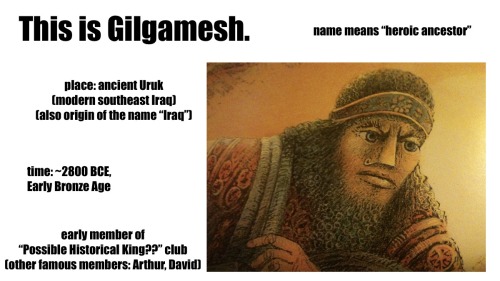
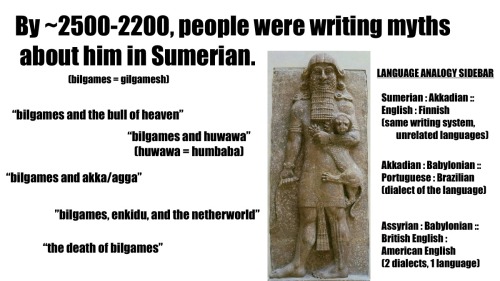
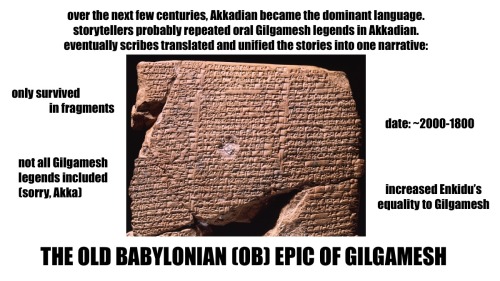
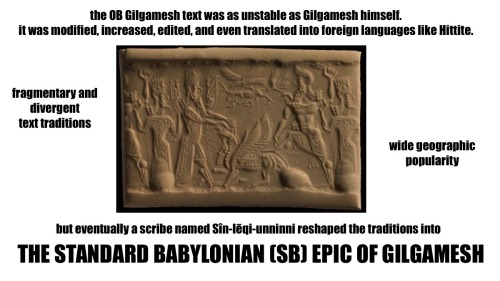
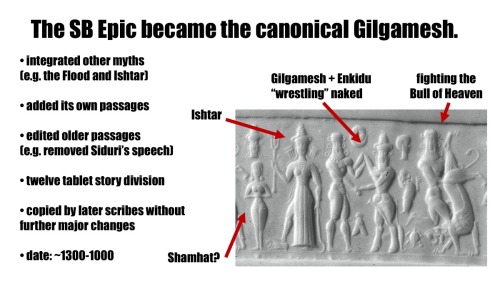
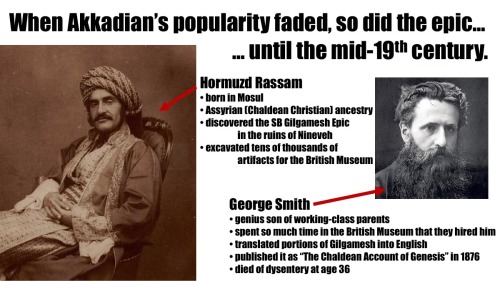
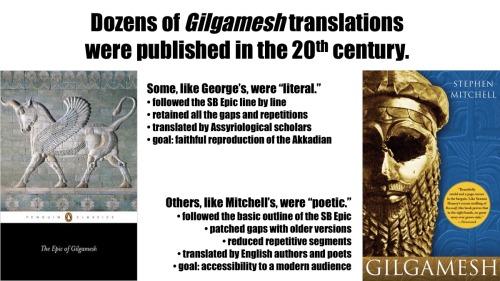
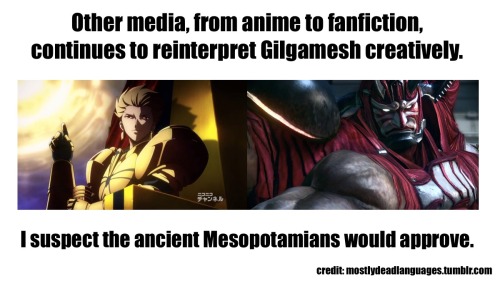
A brief text history of Gilgamesh, put together for my students.
More Posts from Philosophical-amoeba and Others
1729
The number 1729 has an interesting story in mathematics involving the extraordinary Indian mathematician Srinivasa Ramanujan. G. H. Hardy accounts:
“I remember once going to see him (Ramanujan) when he was lying ill at Putney. I had ridden in taxi-cab No. 1729, and remarked that the number seemed to be rather a dull one, and that I hoped it was not an unfavourable omen. ‘No’, he replied, ‘it is a very interesting number; it is the smallest number expressible as the sum of two [positive] cubes in two different ways.’”
Ramanujan had a knack for numbers. Growing up in India at the turn of the 20th century, Ramanujan was largely self-taught. Over his short life time (aged 32), he independently developed nearly 4,000 results in mathematics. He kept his results (without proofs) in notebooks that modern mathematicians are still looking into this day. Nearly all of his results have been proven to be true and have driven research in number theory for the past century. Recently, one of Rumanujan’s results, previously unknown to mathematicians, was an important piece to a 2006 publication.
More at https://en.wikipedia.org/wiki/Srinivasa_Ramanujan
In a recent video, Practical Engineering tackles an important and often-overlooked challenge in civil engineering: dam failure. At its simplest, a levee or dam is a wall built to hold back water, and the higher that water is, the greater the pressure at its base. That pressure can drive water to seep between the grains of soil beneath the dam. As you can see in the demo below, seeping water can take a curving path through the soil beneath a dam in order to get to the other side. When too much water makes it into the soil, it pushes grains apart and makes them slip easily; this is known as liquefaction. As the name suggests, the sediment begins behaving like a fluid, quickly leading to a complete failure of the dam as its foundation flows away. With older infrastructure and increased flooding from extreme weather events, this is a serious problem facing many communities. (Video and image credit: Practical Engineering)



Plantigrade vs. Digitigrade Carnivores - the Polar Bear and the African Lion
The foot structure of many animals plays a critical role in their locomotion and environmental niche, and in carnivores, the clear distinction between plantigrade (walking with the podials and metatarsals both flat on the ground) and digitigrade (walking on the toes, with the heel and wrist permanently raised) animals is most evident.
In plantigrade beasts - which include humans, many rodents, bears, racoons, and opossums - the larger surface area that the many bones provide can act as both a stabilizer and a very effective bearer of great weights. In fact, the big ol’ flighted dinosaurs were plantigrade. At the same time, so were the first (and relatively small) mammals, since both of them needed lots of stability in their feet. The weight-bearing ability and stable platform comes at the cost of speed, as the energy and requirements for movement of so many bones and muscles is much greater than digitigrade feet or unguligrade feet.
Digitigrade animals walk on only their toes, leaving their wrists and ankles permanently raised. This affords more speed, much more silent movement. Cats, birds, and dogs are digitigrade. Digitigrade feet evolved long after plantigrade feet, to fit the niche of mid-sized carnivores. However, they cannot effectively sustain large loads, which is why you cannot use a lion as a pack mule. Well, among other reasons. Really, you just don’t want to try using any mid-sized (or large, in the lion’s case) carnivore as a pack mule.
On the Anatomy of Vertebrates. Richard Owen, 1866.
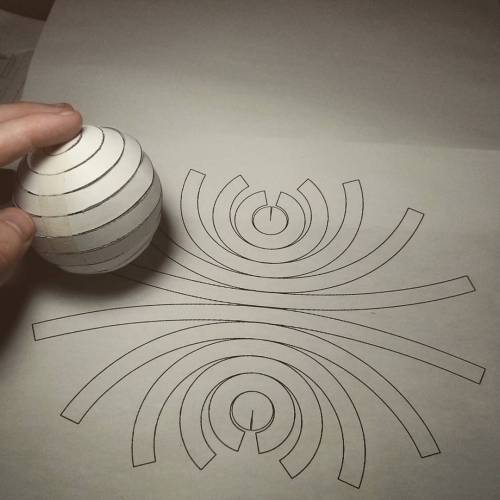
Can you flatten a sphere?
The answer is NO, you can not. This is why all map projections are innacurate and distorted, requiring some form of compromise between how accurate the angles, distances and areas in a globe are represented.
This is all due to Gauss’s Theorema Egregium, which dictates that you can only bend surfaces without distortion/stretching if you don’t change their Gaussian curvature.
The Gaussian curvature is an intrinsic and important property of a surface. Planes, cylinders and cones all have zero Gaussian curvature, and this is why you can make a tube or a party hat out of a flat piece of paper. A sphere has a positive Gaussian curvature, and a saddle shape has a negative one, so you cannot make those starting out with something flat.
If you like pizza then you are probably intimately familiar with this theorem. That universal trick of bending a pizza slice so it stiffens up is a direct result of the theorem, as the bend forces the other direction to stay flat as to maintain zero Gaussian curvature on the slice. Here’s a Numberphile video explaining it in more detail.
However, there are several ways to approximate a sphere as a collection of shapes you can flatten. For instance, you can project the surface of the sphere onto an icosahedron, a solid with 20 equal triangular faces, giving you what it is called the Dymaxion projection.
The Dymaxion map projection.
The problem with this technique is that you still have a sphere approximated by flat shapes, and not curved ones.
One of the earliest proofs of the surface area of the sphere (4πr2) came from the great Greek mathematician Archimedes. He realized that he could approximate the surface of the sphere arbitrarily close by stacks of truncated cones. The animation below shows this construction.
The great thing about cones is that not only they are curved surfaces, they also have zero curvature! This means we can flatten each of those conical strips onto a flat sheet of paper, which will then be a good approximation of a sphere.
So what does this flattened sphere approximated by conical strips look like? Check the image below.
But this is not the only way to distribute the strips. We could also align them by a corner, like this:
All of this is not exactly new, of course, but I never saw anyone assembling one of these. I wanted to try it out with paper, and that photo above is the result.
It’s really hard to put together and it doesn’t hold itself up too well, but it’s a nice little reminder that math works after all!
Here’s the PDF to print it out, if you want to try it yourself. Send me a picture if you do!
Largest Batch of Earth-size, Habitable Zone Planets
Our Spitzer Space Telescope has revealed the first known system of seven Earth-size planets around a single star. Three of these planets are firmly located in an area called the habitable zone, where liquid water is most likely to exist on a rocky planet.
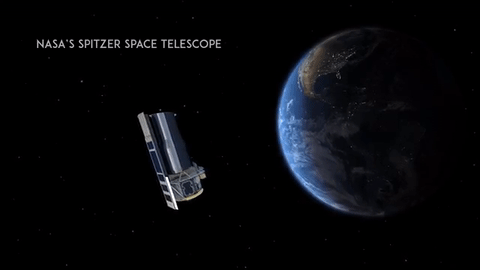
This exoplanet system is called TRAPPIST-1, named for The Transiting Planets and Planetesimals Small Telescope (TRAPPIST) in Chile. In May 2016, researchers using TRAPPIST announced they had discovered three planets in the system.

Assisted by several ground-based telescopes, Spitzer confirmed the existence of two of these planets and discovered five additional ones, increasing the number of known planets in the system to seven.
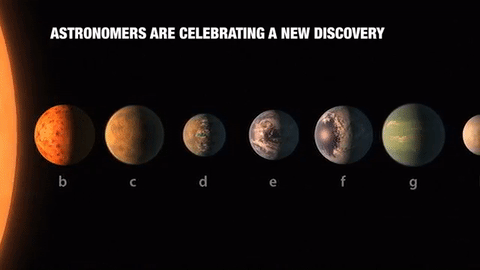
This is the FIRST time three terrestrial planets have been found in the habitable zone of a star, and this is the FIRST time we have been able to measure both the masses and the radius for habitable zone Earth-sized planets.
All of these seven planets could have liquid water, key to life as we know it, under the right atmospheric conditions, but the chances are highest with the three in the habitable zone.

At about 40 light-years (235 trillion miles) from Earth, the system of planets is relatively close to us, in the constellation Aquarius. Because they are located outside of our solar system, these planets are scientifically known as exoplanets. To clarify, exoplanets are planets outside our solar system that orbit a sun-like star.

In this animation, you can see the planets orbiting the star, with the green area representing the famous habitable zone, defined as the range of distance to the star for which an Earth-like planet is the most likely to harbor abundant liquid water on its surface. Planets e, f and g fall in the habitable zone of the star.
Using Spitzer data, the team precisely measured the sizes of the seven planets and developed first estimates of the masses of six of them. The mass of the seventh and farthest exoplanet has not yet been estimated.

For comparison…if our sun was the size of a basketball, the TRAPPIST-1 star would be the size of a golf ball.
Based on their densities, all of the TRAPPIST-1 planets are likely to be rocky. Further observations will not only help determine whether they are rich in water, but also possibly reveal whether any could have liquid water on their surfaces.
The sun at the center of this system is classified as an ultra-cool dwarf and is so cool that liquid water could survive on planets orbiting very close to it, closer than is possible on planets in our solar system. All seven of the TRAPPIST-1 planetary orbits are closer to their host star than Mercury is to our sun.

The planets also are very close to each other. How close? Well, if a person was standing on one of the planet’s surface, they could gaze up and potentially see geological features or clouds of neighboring worlds, which would sometimes appear larger than the moon in Earth’s sky.

The planets may also be tidally-locked to their star, which means the same side of the planet is always facing the star, therefore each side is either perpetual day or night. This could mean they have weather patterns totally unlike those on Earth, such as strong wind blowing from the day side to the night side, and extreme temperature changes.

Because most TRAPPIST-1 planets are likely to be rocky, and they are very close to one another, scientists view the Galilean moons of Jupiter – lo, Europa, Callisto, Ganymede – as good comparisons in our solar system. All of these moons are also tidally locked to Jupiter. The TRAPPIST-1 star is only slightly wider than Jupiter, yet much warmer.
How Did the Spitzer Space Telescope Detect this System?
Spitzer, an infrared telescope that trails Earth as it orbits the sun, was well-suited for studying TRAPPIST-1 because the star glows brightest in infrared light, whose wavelengths are longer than the eye can see. Spitzer is uniquely positioned in its orbit to observe enough crossing (aka transits) of the planets in front of the host star to reveal the complex architecture of the system.

Every time a planet passes by, or transits, a star, it blocks out some light. Spitzer measured the dips in light and based on how big the dip, you can determine the size of the planet. The timing of the transits tells you how long it takes for the planet to orbit the star.

The TRAPPIST-1 system provides one of the best opportunities in the next decade to study the atmospheres around Earth-size planets. Spitzer, Hubble and Kepler will help astronomers plan for follow-up studies using our upcoming James Webb Space Telescope, launching in 2018. With much greater sensitivity, Webb will be able to detect the chemical fingerprints of water, methane, oxygen, ozone and other components of a planet’s atmosphere.
At 40 light-years away, humans won’t be visiting this system in person anytime soon…that said…this poster can help us imagine what it would be like:

Make sure to follow us on Tumblr for your regular dose of space: http://nasa.tumblr.com



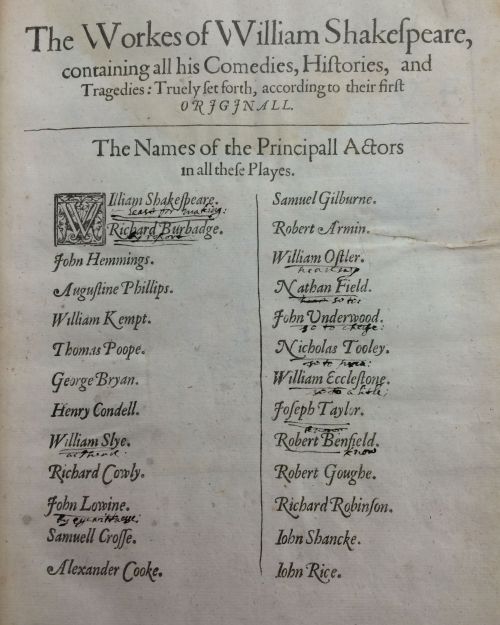
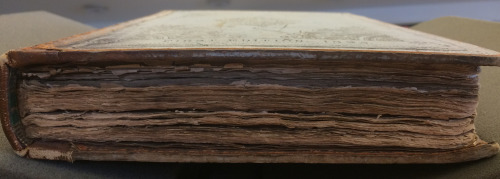




Happy almost birthday, Shakespeare! Or should I say Bard-thday? Recently, in honour of the 400th anniversary of William Shakespeare’s death (conveniently for celebratory purposes, he was born on April 23 1564 and died on the same day in 1616), I was given the incredible opportunity to have a private audience to go through the University of Glasgow’s copy of the First Folio, page by page. I’ve written a short article for the University Library’s blog, which you can find here, but I wanted to share some other images on my own blog that I didn’t have room for on the official post!
The University of Glasgow’s First Folio (more properly known as Mr. William Shakespeare’s Comedies, Histories, & Tragedies) is able to tell so many more stories than those of the plays contained in its pages- of the history of the antiquarian book trade, of the printing practices of the Renaissance, of book ownership and value. Rest assured, you’ll probably be seeing posts from me in the future about all of these things, as well as the typographical ornaments used in the book, which I found fascinating. The University’s Folio is particularly interesting due to the notations by past owners, including one who had apparently seen at least one of the original Chamberlain’s Men “By eyewittnesse”. But my favourite bit of the later additions is the morbid little poem on the reverse of one of the flyleaves: “Pitty it is the fam’d Shakespeare/ Shall ever want his chin or haire.”


It’s easy: Form a triangle, then a hexagon, then a bicycle wheel
This is the general mechanism on how a spider spins its web (talk about engineering, right?). When an insect gets caught in its web, the vibrations caused by the insect is felt by the spider which then rushes to engulf its prey.
Now here is the trippy part ; This is the effect of drugs on the pattern of the web.


Hope you are having a great week. Have a good one!
* Spider spinning a web (video) (if you find a better full video let us know)
** Spiders on drugs - NASA article ; Video
Don’t play, play - Singlish is studied around the globe
Blogger Wendy Cheng’s Web video series Xiaxue’s Guide To Life and Jack Neo’s Ah Boys To Men film franchise are well-known shows among Singaporeans. For one thing, they are filled with colloquial terms, local references and copious doses of Singlish terms such as “lah” and “lor”.
But they are not merely for entertainment. In recent years, such shows have found a place in universities around the world, where linguists draw on dialogues used in these local productions to introduce to undergraduates and postgraduate students how Singlish has become a unique variety of the English language.
This comes even as concerns have been raised over how Singlish could impede the use of standard English here.
From Italy and Germany to Japan, at least seven universities around the world have used Singlish as a case study in linguistics courses over the past decade. This is on top of more than 40 academics outside of Singapore - some of whom were previously based here - who have written books or papers on Singlish as part of their research.




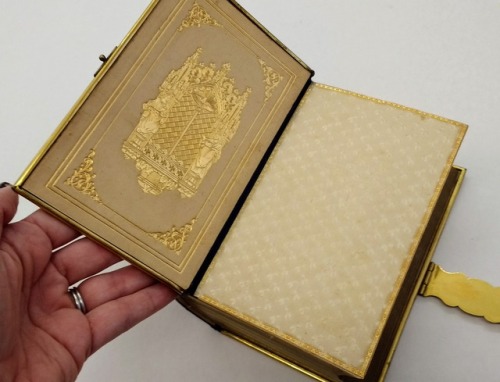

Earlier this semester, I got this book out for a class on the material culture of Christianity. It’s a beautiful Bible bound in purple velvet, with gold embellishments, edges, and clasps. It originally came in a leather case lined with silk, which has since fallen to pieces at the joints, but the same silk features on the gilded endpapers. The clasp is even engraved with the initials of the book’s first owner, Josephine Bonaparte Bolton.
This book is beautiful, but it’s even more interesting after reading the note that came with it from its donor, Josephine’s granddaughter:
When Josephine Bonaparte Bolton was sixteen years old, she taught three negro women to read and write. Her mother, Mrs. Wm. Bolton, was so proud of her daughter’s achievement, that she gave her this little Bible as a memento. The Boltons lived in Jefferson City, Missouri.
Josephine Bolton Kerns (Granddaughter)
June 1, 1977
The clasp is dated 1851, which means that the original Josephine broke Missouri law by giving reading and writing lessons to the three African American women mentioned in the note. Missouri law in 1847 stated that “No person shall keep or teach any school for the instruction of negroes or mulattos, in reading or writing, in this State.” Teaching a person of color to read was punishable by a fine of not less than $500 and up to six months in jail.
I could not find any information about either Josephine, but for the most part, the Bolton families of Cole County and Jefferson City seem to have been Confederate sympathizers. Dr. William Bolton, who may have been Josephine’s father, was a prominent Jefferson City physician and a known slave owner. I’d love to know more about Josephine, her mother, and the story behind this beautiful book. Wouldn’t you?
- Kelli
The Holy Bible, containing the Old and New Testaments : translated out of the original tongues, and with the former translations diligently compared and revised, by His Majesty’s special command, appointed to be read in churches. London : Eyre and Spottiswoode, 1848. Rare BS185 1848 .L6
What’s Up for May 2016?

What’s Up for May? Two huge solar system highlights: Mercury transits the sun and Mars is closer to Earth than it has been in 11 years.

On May 9, wake up early on the west coast or step out for coffee on the east coast to see our smallest planet cross the face of the sun. The transit will also be visible from most of South America, western Africa and western Europe.

A transit occurs when one astronomical body appears to move across the face of another as seen from Earth or from a spacecraft. But be safe! You’ll need to view the sun and Mercury through a solar filter when looking through a telescope or when projecting the image of the solar disk onto a safe surface. Look a little south of the sun’s Equator. It will take about 7 ½ hours for the tiny planet’s disk to cross the sun completely. Since Mercury is so tiny it will appear as a very small round speck, whether it’s seen through a telescope or projected through a solar filter. The next Mercury transit will be Nov. 11, 2019.

Two other May highlights involve Mars. On May 22 Mars opposition occurs. That’s when Mars, Earth and the sun all line up, with Earth directly in the middle.

Eight days later on May 30, Mars and Earth are nearest to each other in their orbits around the sun. Mars is over half a million miles closer to Earth at closest approach than at opposition. But you won’t see much change in the diameter and brightness between these two dates. As Mars comes closer to Earth in its orbit, it appears larger and larger and brighter and brighter.

During this time Mars rises after the sun sets. The best time to see Mars at its brightest is when it is highest in the sky, around midnight in May and a little earlier in June.

Through a telescope you can make out some of the dark features on the planet, some of the lighter features and sometimes polar ice and dust storm-obscured areas showing very little detail.

After close approach, Earth sweeps past Mars quickly. So the planet appears large and bright for only a couple weeks.

But don’t worry if you miss 2016’s close approach. 2018’s will be even better, as Mars’ close approach will be, well, even closer.
You can find out about our #JourneytoMars missions at mars.nasa.gov, and you can learn about all of our missions at http://www.nasa.gov.
Make sure to follow us on Tumblr for your regular dose of space: http://nasa.tumblr.com
-
 glorioussuitcat reblogged this · 2 months ago
glorioussuitcat reblogged this · 2 months ago -
 glorioussuitcat liked this · 2 months ago
glorioussuitcat liked this · 2 months ago -
 oldcarinthemiddleofnowhere liked this · 3 months ago
oldcarinthemiddleofnowhere liked this · 3 months ago -
 shiverelectric reblogged this · 8 months ago
shiverelectric reblogged this · 8 months ago -
 shiverelectric liked this · 8 months ago
shiverelectric liked this · 8 months ago -
 kingtoyourwarlock reblogged this · 8 months ago
kingtoyourwarlock reblogged this · 8 months ago -
 neuromagpie reblogged this · 8 months ago
neuromagpie reblogged this · 8 months ago -
 silverthroatednightingale reblogged this · 8 months ago
silverthroatednightingale reblogged this · 8 months ago -
 treestar liked this · 1 year ago
treestar liked this · 1 year ago -
 deegondragon liked this · 1 year ago
deegondragon liked this · 1 year ago -
 pithoselpis liked this · 1 year ago
pithoselpis liked this · 1 year ago -
 entidy13 reblogged this · 1 year ago
entidy13 reblogged this · 1 year ago -
 entidy13 liked this · 1 year ago
entidy13 liked this · 1 year ago -
 lowthebridge liked this · 2 years ago
lowthebridge liked this · 2 years ago -
 coffeeloversposts liked this · 2 years ago
coffeeloversposts liked this · 2 years ago -
 reefadamus liked this · 2 years ago
reefadamus liked this · 2 years ago -
 dal6 liked this · 2 years ago
dal6 liked this · 2 years ago -
 coffeeloversposts reblogged this · 2 years ago
coffeeloversposts reblogged this · 2 years ago -
 negative1humans liked this · 2 years ago
negative1humans liked this · 2 years ago -
 a-peculiar-potoo reblogged this · 3 years ago
a-peculiar-potoo reblogged this · 3 years ago -
 a-peculiar-potoo liked this · 3 years ago
a-peculiar-potoo liked this · 3 years ago -
 weeaboo-god reblogged this · 3 years ago
weeaboo-god reblogged this · 3 years ago -
 weeaboo-god liked this · 3 years ago
weeaboo-god liked this · 3 years ago -
 coffeeloversposts reblogged this · 3 years ago
coffeeloversposts reblogged this · 3 years ago -
 berensreverie liked this · 3 years ago
berensreverie liked this · 3 years ago -
 lilithwishtolivefree liked this · 3 years ago
lilithwishtolivefree liked this · 3 years ago -
 deactivated-account-anon liked this · 3 years ago
deactivated-account-anon liked this · 3 years ago
A reblog of nerdy and quirky stuff that pique my interest.
291 posts